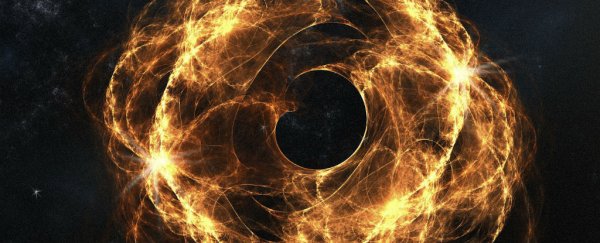For the first time ever, a team of astronomers might have witnessed the birth of a black hole, roughly 20 million light-years from Earth.
While researchers have long thought that black holes form when supergiant stars collapse, new data from the Hubble Space Telescope might finally confirm this hypothesis.
"This may be the first direct clue to how the collapse of a star can lead to the formation of a black hole," astronomer Avi Loeb from Harvard University, who was not a part of the new research, told Anna Nowogrodzki at New Scientist.
The team, led by Christopher Kochanek from Ohio State University, discovered what appears to be a newly forming black hole while going through previously collected data from the Hubble Space Telescope, which was trained in on a red supergiant star known as N6946-BH1.
According to Nowogrodzki, N6946-BH1 - a star roughly 25 times more massive than our Sun - was originally observed back in 2004. Since then, Hubble has been keeping its eye on the star's movements and activity.
After combing through that data, Kochanek's team says they've discovered that the star flared up in 2009, becoming about 1 million times brighter than the Sun, before slowly fading away.
Comparing this to new Hubble observations, which suggest that the star is no longer emitting visible wavelength light, the team suspects that N6946-BH1 might have triggered a black hole birth.
The hypothesis is that N6946-BH1 could have collapsed in recent years, and that bright flare-up in 2009 was the result of the star shedding off its neutrinos.
This would have caused the star's gravitational pull to drop, allowing electrons to reattach to the hydrogen ions that float around it - a process that can eventually result in the birth of a black hole.
If this scenario is correct, Hubble has just captured the first ever obsersations of a black hole birth, though further investigation is needed to prove it.
To confirm the black hole birth, the team will need to discount a number of other possibilities that could have caused the star to flare up and disappear, such as a merger with another star, or the chance that it's maybe being hidden from Hubble's view by a curtain of dust.
While these are definitely possibilities, Nowogrodzki points out that a merger with another star would cause a much brighter flare-up that wouldn't dissipate in under a year, and if dust is to blame, the star should pop out of it eventually.
The current findings have not yet been peer-reviewed, which means for now, we have to take them with a grain of salt.
But to speed up the investigation, the team plans on continuing their observation of the star - or potential baby black hole - with Hubble and NASA's Chandra X-ray Observatory.
With the help of both of these high-powered telescopes, they should be able to collect the data they need to confirm or disprove their hypothesis.
Kochanek is cautiously optimistic, telling New Scientist: "I'm not quite at 'I'd bet my life on it' yet, but I'm willing to go for your life."
The findings have been published on pre-print website arXiv.org.

